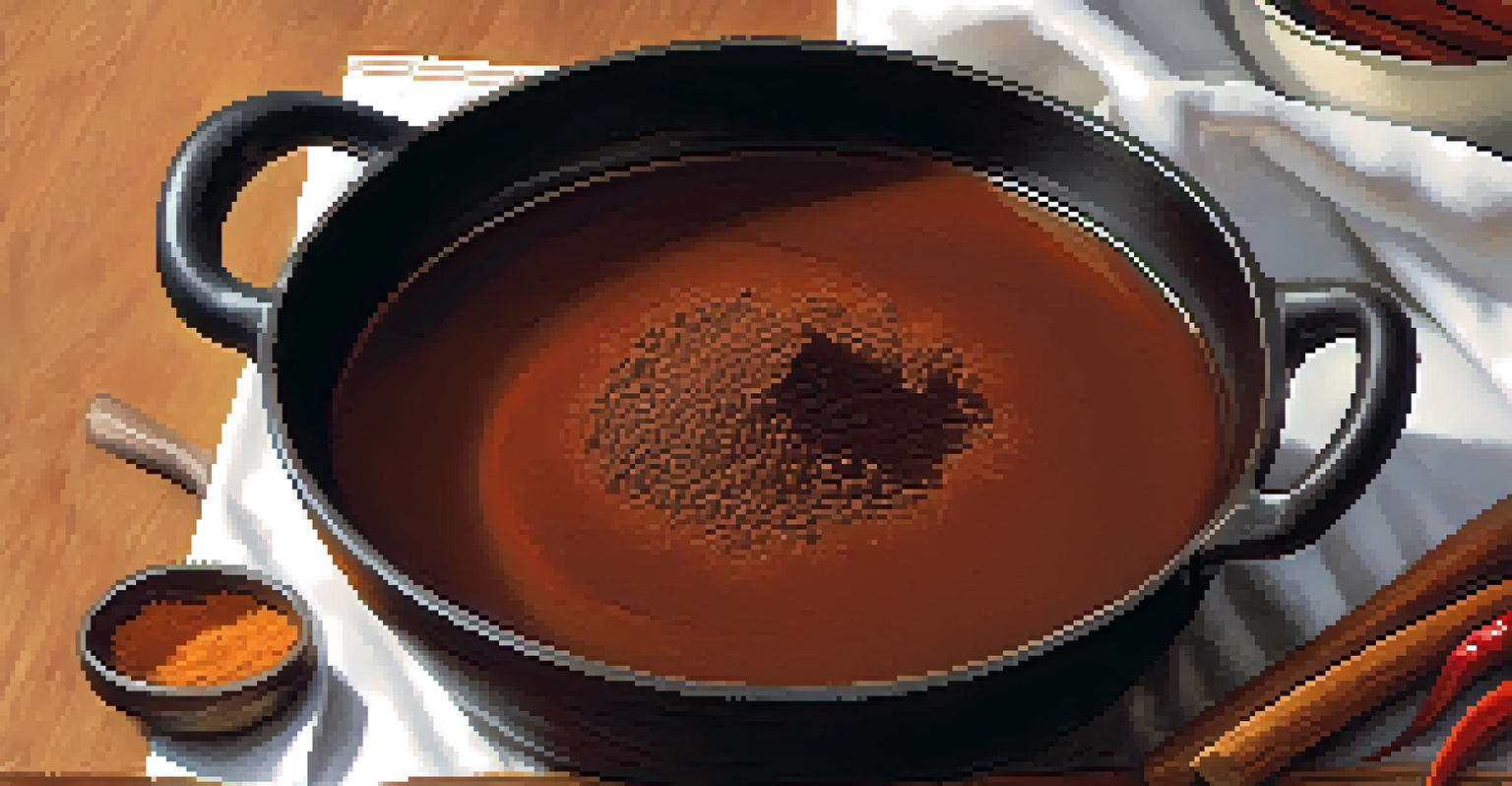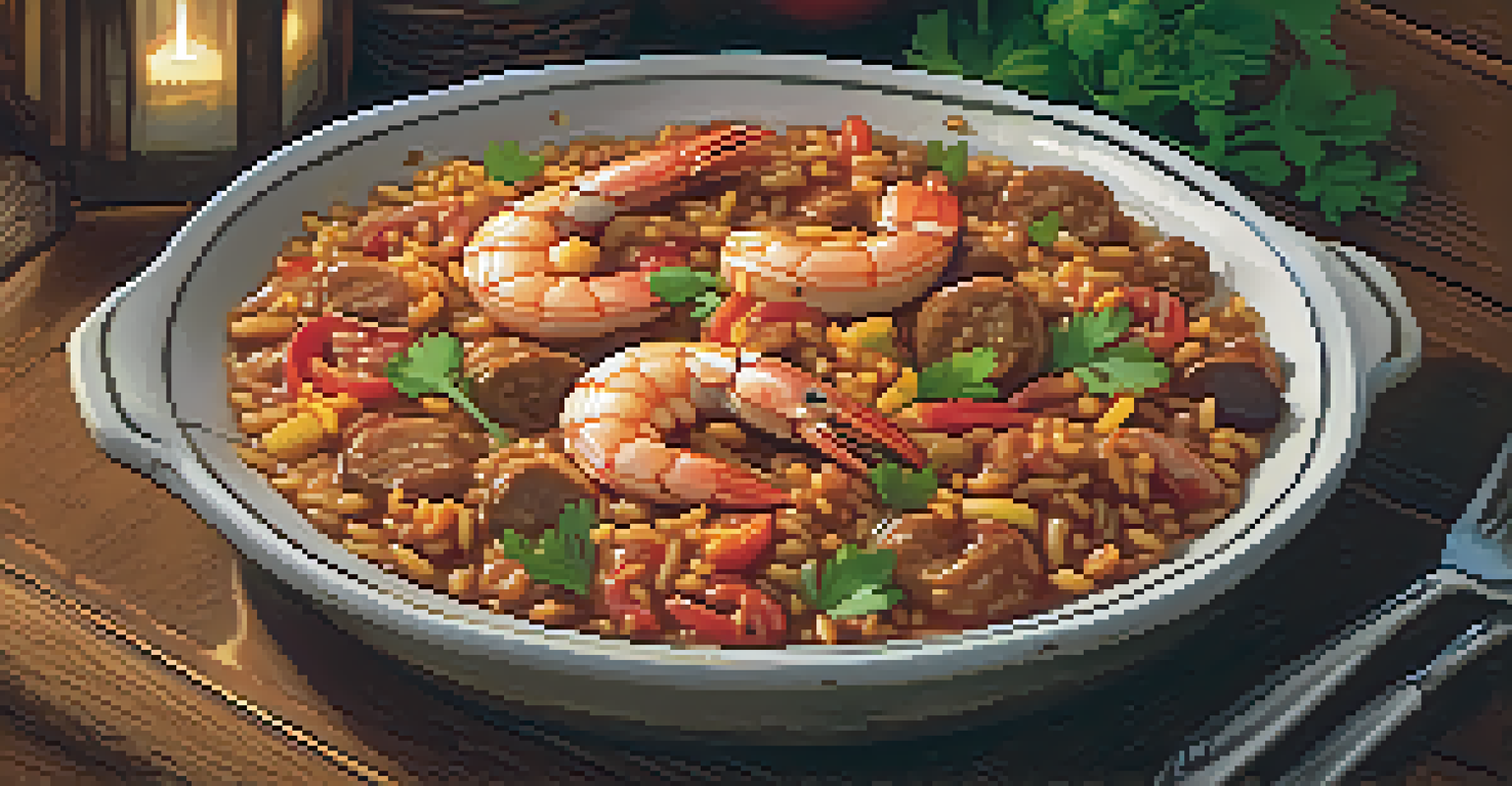Cooking Techniques Unique to Louisiana Cuisine

Understanding the Holy Trinity of Louisiana Cooking
At the heart of Louisiana cuisine lies the Holy Trinity, a flavor foundation made up of onions, bell peppers, and celery. This aromatic trio is essential in many dishes, providing a depth of flavor and a fragrant base that enhances everything from gumbo to jambalaya. Think of it as the Louisiana equivalent of mirepoix, but with a unique twist that truly captures the region's essence.
Cooking is like love. It should be entered into with abandon or not at all.
The Holy Trinity is often sautéed in oil or butter to release its natural flavors before other ingredients are added. This technique is not just about cooking; it’s about layering flavors to create a rich, savory profile that is synonymous with Southern cooking. Many chefs will tell you that this simple step can make all the difference in achieving that authentic Louisiana taste.
By incorporating the Holy Trinity into your dishes, you’re not only following traditional recipes but also embracing a cultural heritage that values bold flavors and fresh, local ingredients. It’s a technique that invites creativity, allowing cooks to experiment while still honoring the culinary roots of Louisiana.
Mastering the Art of Roux in Louisiana Dishes
Roux is a cornerstone of many Louisiana dishes, acting as a thickening agent and a flavor enhancer. Made from equal parts flour and fat, roux can range in color from light blonde to deep chocolate brown, with each hue bringing its own distinct taste and character. The process requires patience and attention, as the flour must be cooked slowly to achieve the desired color without burning.

In dishes like gumbo and étouffée, a dark roux offers a nutty flavor that forms the backbone of the dish. It’s a labor of love, as stirring the mixture continuously for up to an hour can transform simple ingredients into a rich, complex sauce. This technique not only showcases the cook's skill but also reflects the time-honored traditions of Louisiana cuisine.
The Holy Trinity of Flavor
Onions, bell peppers, and celery create the essential flavor base for many Louisiana dishes.
When making roux, it’s essential to remember that the darker the roux, the less thickening power it has. This means you’ll need to adjust your recipes accordingly, balancing flavors and textures. Mastering roux can elevate home-cooked meals, inviting a taste of Louisiana's culinary history right into your kitchen.
The Soul of Cajun Cooking: One-Pot Meals
Cajun cooking is often celebrated for its hearty one-pot meals, which exemplify the region's resourceful approach to food. Dishes like jambalaya, gumbo, and red beans and rice not only feed the body but also bring families together around the table. These recipes are deeply rooted in tradition, often passed down through generations, making them a source of pride and nostalgia for many.
Food is not just what we eat, but a connection to our culture and heritage.
The beauty of one-pot meals lies in their simplicity and the ability to blend various ingredients into a harmonious dish. By layering flavors and allowing everything to simmer together, cooks can create complex and satisfying meals with minimal fuss. It’s like a culinary symphony where all the instruments come together to create a delightful experience.
Moreover, one-pot meals are often budget-friendly, making them accessible to everyone. They encourage creativity, as cooks can use whatever ingredients they have on hand, reflecting the adaptability that is a hallmark of Cajun cuisine. This approach not only minimizes waste but also reminds us that great food doesn’t have to be complicated.
Embracing the Slow Cook: Louisiana’s Stews and Gumbos
Slow cooking is a cherished technique in Louisiana, particularly when it comes to stews and gumbos. The magic of these dishes lies in their long cooking times, which allow flavors to meld and deepen. This method emphasizes the importance of patience, as the best gumbos are often simmered for hours, developing a rich, savory broth that warms the soul.
At the heart of a great gumbo is the careful layering of ingredients, starting with the Holy Trinity and roux, followed by a medley of meats, seafood, and spices. Each component contributes to the overall flavor, creating a symphony of tastes that is both comforting and complex. It’s a perfect example of how time can transform simple ingredients into something extraordinary.
Roux: The Heart of Louisiana Cooking
Roux serves as both a thickening agent and flavor enhancer, requiring patience and skill to master.
The communal aspect of slow cooking also plays a significant role in Louisiana culture. Family and friends often gather to share in the preparation, making it a social event as much as a culinary one. This connection to community and tradition is what makes Louisiana stews and gumbos so special, turning every meal into a celebration.
The Influence of Creole Cuisine on Cooking Techniques
Creole cuisine, with its diverse influences, has significantly shaped Louisiana's cooking techniques. It embodies a blend of flavors from French, Spanish, African, and Caribbean cultures, creating a vibrant culinary landscape. This fusion is evident in the use of unique spices, herbs, and cooking methods that set Creole dishes apart from their Cajun counterparts.
Techniques like sautéing, flambéing, and baking in cast-iron skillets are commonly used in Creole cooking, showcasing the versatility of this culinary style. For instance, dishes like shrimp Creole highlight the importance of seasoning and the art of balancing flavors, resulting in a meal that is both visually appealing and mouth-wateringly delicious. It’s about celebrating the ingredients and letting them shine.
Creole cooking also emphasizes presentation, often featuring colorful ingredients and intricate plating. This focus on aesthetics reflects a cultural appreciation for beauty and hospitality, making each meal a feast for the senses. By embracing these techniques, cooks can honor the rich traditions of Louisiana's culinary heritage while adding their personal touch.
Frying: A Signature Technique in Louisiana Cuisine
Frying is a beloved cooking technique in Louisiana, celebrated for its ability to create crispy, flavorful dishes. Whether it’s fried catfish, beignets, or chicken, the process of frying not only adds texture but also enhances the overall taste. This method is deeply ingrained in Louisiana culture, often associated with gatherings, celebrations, and family traditions.
The key to perfect frying lies in the choice of oil and temperature control. Using oil that's heated to the right temperature ensures that food cooks evenly, achieving that coveted golden-brown exterior without becoming greasy. Many cooks will use a cast-iron skillet, which retains heat beautifully and adds a touch of authenticity to the frying process.
One-Pot Meals Bring Communities Together
Cajun one-pot meals like gumbo and jambalaya reflect tradition and resourcefulness, fostering family and community connection.
Moreover, frying allows for creativity and experimentation with seasonings and batters. From spicy marinades to sweet coatings, the possibilities are endless. This technique invites home cooks to put their spin on traditional recipes, ensuring that the spirit of Louisiana cuisine continues to evolve while still honoring its roots.
The Role of Spices and Seasonings in Louisiana Cooking
Spices and seasonings are the lifeblood of Louisiana cuisine, infusing dishes with vibrant flavors and character. Cajun and Creole cooks often rely on a blend of herbs and spices, such as paprika, cayenne, thyme, and bay leaves, to create that signature kick. This emphasis on seasoning is what sets Louisiana cooking apart, ensuring that every bite is a burst of flavor.
The use of spices is not just about heat; it’s about balance and harmony. Cooks carefully choose their seasonings to complement the natural flavors of the ingredients, enhancing rather than overpowering them. This thoughtful approach is evident in dishes like gumbo, where spices work together to create a beautifully layered flavor profile.

In addition to traditional spices, Louisiana cuisine also embraces the use of fresh herbs, like parsley and green onions, to brighten dishes. This combination of dried and fresh ingredients showcases the region's commitment to using quality components, resulting in meals that are both flavorful and fresh. By understanding the role of spices and seasonings, cooks can truly capture the essence of Louisiana in their cooking.